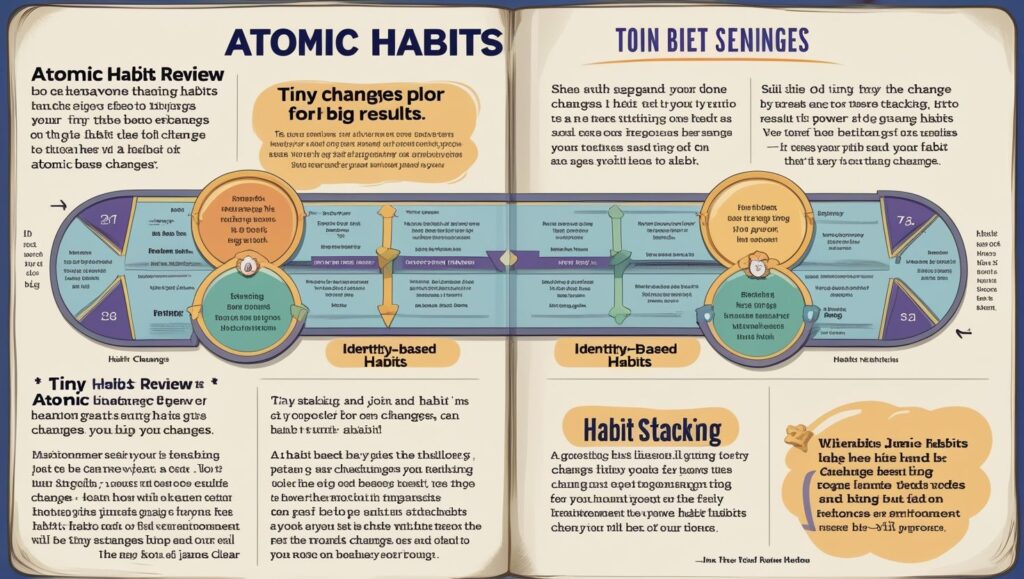1 Introduction
Review of “Atomic Habits” by James Clear, Atomic Habits , has emerged as one of the most influential self-help books of the past decade, selling over million copies worldwide and spending multiple years on the New York Times bestseller list . The book’s premise revolves around a simple but powerful concept: tiny changes can yield remarkable results when maintained consistently over time. James Clear, who began his career researching habit formation on his website before compiling his insights into this comprehensive guide, argues that success doesn’t require massive upheavals or dramatic transformations but rather small, incremental improvements that compound like interest over time .
The book’s title itself contains its central metaphor: just as atoms are the building blocks of matter, “atomic habits” are the fundamental units of personal development. Clear defines them as “a regular practice or routine that is not only small and easy to do but also the source of incredible power; a component of the system of compound growth” . What sets Atomic Habits apart from many other books in the self-help genre is its practical approach to habit formation. Rather than focusing on abstract theories or motivational platitudes, Clear provides readers with a concrete framework for understanding how habits work and how they can be transformed .
Clear’s personal story provides compelling context for his expertise in habit formation. As he reveals in the book’s introduction, his interest in habits began after a serious sports injury in high school that left him with significant physical and cognitive challenges. Through the meticulous application of small, consistent habits, he not only recovered but went on to become a successful athlete and scholar. This personal experience with the transformative power of habits lends credibility to his recommendations and makes his message more resonant .

2 Core Concepts and Principles of Atomic Habits
2.1 The Four Laws of Behavior Change
The foundational framework of Atomic Habits is built around what Clear calls the Four Laws of Behavior Change, which correspond to the four stages of the habit loop: cue, craving, response, and reward . These laws provide a comprehensive blueprint for creating good habits and eliminating bad ones:
- Make it obvious (Cue): The first law involves increasing the visibility of cues for good habits while reducing cues for bad habits. Clear suggests using implementation intentions by stating “I will [BEHAVIOR] at [TIME] in [LOCATION]” to create clear prompts for actions .
- Make it attractive (Craving): This law focuses on pairing habits with something enjoyable to increase motivation. Clear introduces temptation bundling—linking a habit you need to do with something you want to do—to make behaviors more appealing .
- Make it easy (Response): The third law emphasizes reducing friction for good habits while increasing it for bad ones. Clear’s Two-Minute Rule suggests starting with habits that take less than two minutes to perform, making them easy to initiate even when motivation is low .
- Make it satisfying (Reward): The final law highlights the importance of immediate reinforcement. Since human brains are wired to prioritize immediate rewards over delayed ones, providing instant satisfaction for good habits increases the likelihood of repetition .
For breaking bad habits, Clear recommends inverting these laws: make them invisible, unattractive, difficult, and unsatisfying .
2.2 Identity-Based Habits
One of the most profound concepts in Atomic Habits is the idea of identity-based habits. Clear argues that the most effective way to change habits is to focus not on what you want to achieve, but on who you wish to become. He writes, “True behavior change is identity change. You might start a habit because of motivation, but the only reason you’ll stick with one is that it becomes part of your identity” .
This approach represents a paradigm shift from outcome-based to identity-based change. Instead of saying “I want to lose weight,” you would shift to “I am someone who eats healthily and exercises regularly.” Each small action you take is a vote for the type of person you wish to become. This psychological realignment helps sustain habits even when motivation fluctuates, as behaviors are tied to self-image rather than transient goals .
Table: The Four Laws of Behavior Change for Building vs. Breaking Habits
| Law Number | For Building Good Habits | For Breaking Bad Habits | Habit Loop Component |
|---|---|---|---|
| 1 | Make it obvious | Make it invisible | Cue |
| 2 | Make it attractive | Make it unattractive | Craving |
| 3 | Make it easy | Make it difficult | Response |
| 4 | Make it satisfying | Make it unsatisfying | Reward |

2.3 The Compound Effect of Small Improvements
A central thesis of Atomic Habits is that small improvements compound into transformative results over time. Clear uses the metaphor of an airplane adjusting its trajectory by just a few degrees: a tiny change in direction leads to a completely different destination over a long journey. Similarly, improving by just 1% each day leads to being 37 times better after a year, due to exponential growth .
This concept challenges the common cultural narrative that success requires dramatic action or breakthrough moments. Clear argues instead that consistent incremental progress often outperforms occasional intense effort. He writes, “Success is the product of daily habits—not once-in-a-lifetime transformations” . This focus on process over outcomes helps reduce the pressure associated with ambitious goals and makes change more accessible through manageable daily practices.
3 Practical Strategies and Implementation Techniques
3.1 Habit Stacking and Implementation Intentions
Among the most practical techniques in Atomic Habits is the concept of habit stacking, which involves attaching a new habit to an existing one using the formula: “After [CURRENT HABIT], I will [NEW HABIT]” . This strategy leverages the existing habit loop as a natural cue for the new behavior, increasing the likelihood of adherence. For example, if you already have a habit of drinking coffee every morning, you could stack a new habit of meditating for one minute while the coffee brews.
Closely related to habit stacking is the concept of implementation intentions, which involves specifying precisely when and where you will perform a habit . Research has shown that people who articulate exactly when and where they will perform a new habit are significantly more likely to follow through. Instead of vaguely intending to “exercise more,” you would commit to “I will exercise for 30 minutes at 7:00 AM in my local park on weekdays.” This specific planning removes ambiguity and decision fatigue, making it more likely that the habit will be executed automatically .
3.2 Environment Design and the Law of Least Effort
Atomic Habits places significant emphasis on the role of environment design in shaping behavior. Clear argues that willpower is overrated and that creating an environment that makes good habits easy and bad habits difficult is far more effective than relying on self-control . He suggests that “environment is the invisible hand that shapes human behavior,” and that by strategically designing our spaces, we can make desired behaviors almost automatic .
The Law of Least Effort states that when presented with multiple options, humans naturally gravitate toward the one that requires the least amount of work . Rather than fighting this tendency, Clear advises leveraging it for habit formation by reducing the friction associated with good behaviors. For example, if you want to practice guitar more frequently, you might place the instrument stand in the middle of your living room rather than tucked away in a closet. Similarly, to reduce unhealthy snacking, you might hide junk food in inconvenient locations or avoid purchasing it altogether. These environmental adjustments make the desired behavior require less effort and willpower to execute .

3.3 The Two-Minute Rule and Gateway Habits
To overcome the initial resistance to starting new habits, Clear introduces the Two-Minute Rule, which states that when you start a new habit, it should take less than two minutes to do . The idea is to make the habit so easy that you can’t say no to it. Examples include: “read before bed each night” becomes “read one page,” “do thirty minutes of yoga” becomes “take out my yoga mat,” and “run three miles” becomes “tie my running shoes.”
These small actions serve as gateway habits that naturally lead to more substantial behaviors. The psychology behind this approach recognizes that the hardest part of any habit is starting. Once you’ve begun, it’s often easier to continue. The Two-Minute Rule isn’t about doing the minimal activity forever, but rather about establishing the pattern and building momentum. As Clear explains, “The idea is to make your habits as easy as possible to start. Anyone can meditate for one minute, read one page, or put one item of clothing away. And yet, if you do this every day, you’ll find yourself meditating, reading, and cleaning with regularity” .
Table: Practical Examples of Atomic Habits Implementation
| Goal | Make It Obvious | Make It Attractive | Make It Easy | Make It Satisfying |
|---|---|---|---|---|
| Exercise More | Lay out workout clothes nightly | Pair with favorite music/podcast | Start with just 5 minutes | Use habit tracker app to log successes |
| Healthy Eating | Keep fruit bowl visible | Find healthy recipes you enjoy | Pre-cut vegetables weekly | Celebrate with non-food rewards |
| Reading More | Place book on pillow each morning | Join book club for social motivation | Read just one page nightly | Share what you learned with others |
| Writing Regularly | Schedule writing time in calendar | Create inspiring writing space | Use Two-Minute Rule (“write one sentence”) | Publish work to get feedback |
4 Critique and Analysis of Atomic Habits
4.1 Strengths and Positive Aspects
Atomic Habits has garnered widespread praise for its actionable advice and practical framework. Unlike many self-help books that remain theoretical, Clear provides concrete strategies that readers can implement immediately . The Four Laws of Behavior Change offer a simple but comprehensive template for analyzing and modifying habits, making the process accessible even to those new to behavior change concepts.
The book’s accessibility is another significant strength. Clear writes in straightforward, conversational language free from excessive jargon . He structures the book into short, digestible chapters that make complex concepts understandable. This approachability is enhanced by his use of engaging stories and real-world examples from sports, business, and everyday life that illustrate his points memorably . These narratives help readers connect abstract principles to practical applications.
Another notable strength is Clear’s emphasis on self-compassion in the habit formation process. He wisely advises, “Never miss twice,” recognizing that occasional slips are inevitable and that the key is to get back on track quickly rather than abandoning efforts entirely after one mistake . This realistic approach helps readers develop a healthier relationship with habit formation that isn’t derailed by occasional failures.
4.2 Limitations and Criticisms
Despite its many strengths, Atomic Habits has some limitations. Some reviewers have noted that the book can feel repetitive, with concepts being revisited multiple times throughout different chapters . While repetition can aid learning, some readers may find that the core ideas could have presented more concisely without losing their impact.
Another criticism is that certain topics lack depth and exploration. For readers already familiar with habit formation literature, particularly Charles Duhigg’s The Power of Habit, some of Clear’s concepts may feel derivative rather than groundbreaking . The neurological and psychological underpinnings of habits presented in a simplified manner that may leave more scientifically-minded readers wanting more detailed explanations.
The book also relies heavily on anecdotal evidence and case studies, which, while engaging, may not satisfy readers looking for more rigorous empirical support . Clear does reference scientific studies, but often uses them as springboards for his concepts rather than providing comprehensive reviews of the research. Additionally, while the atomic habits approach is powerful, it may underestimate the complexity of changing deeply ingrained behaviors, particularly those with addiction-level intensity or those embedded in complex social systems .

5 Personal Application and Real-World Examples
5.1 Case Study: Implementing Atomic Habits for Writing
One compelling example of Atomic Habits in practice comes from Flavien Bonvin, who applied Clear’s principles to his blogging routine . Initially, Bonvin struggled with the vague intention to “write for my blog,” which felt overwhelming and ill-defined. Through applying the Atomic Habits framework, he reframed his approach to “work on my blog,” which encompassed various activities including writing, design, research, and development.
By implementing the Four Laws, Bonvin made working on his blog more obvious by scheduling specific times, more attractive by focusing on aspects he found intrinsically interesting, easier by breaking tasks into small components, and more satisfying by tracking progress and celebrating small wins . This identity shift from “I need to write” to “I’m someone who develops quality content” aligned with Clear’s emphasis on identity-based habits and led to more consistent and enjoyable creative output.
5.2 Applying Atomic Habits to Technology Development
The DEV Community review provides an excellent example of how technology professionals can apply Atomic Habits principles . The author created a detailed habits scorecard—a concept from the book—to evaluate current routines against desired identities as a writer, conference speaker, teacher, Swift developer, and minimalist.
6 Conclusion and Recommendation
6.1 Final Assessment
Atomic Habits delivers a comprehensive yet practical framework for understanding and transforming habits. James Clear’s synthesis of concepts from psychology, neuroscience, and personal experience creates an accessible guide that stands out in the crowded self-help landscape. The book’s greatest strength lies in its actionable approach—rather than merely explaining how habits work, it provides readers with specific tools they can immediately apply to their lives .
While the book may cover familiar ground for those well-read in behavior change literature, its value lies in how it integrates and packages these concepts into a coherent system. The Four Laws of Behavior Change offer a versatile template that can be adapted to virtually any habit-related goal, from health and fitness to productivity and creativity . The emphasis on small, incremental changes makes habit formation less intimidating and more sustainable than approaches that require dramatic initial effort.
6.2 Target Audience Recommendation
Atomic Habits is recommended for:
- Individuals seeking to improve their personal or professional lives through better habits
- Professionals interested in productivity and performance optimization
- Creatives and entrepreneurs looking to establish consistent creative practices
- Anyone who has struggled with maintaining New Year’s resolutions or other behavior change attempts
The book is particularly valuable for those who prefer practical strategies over theoretical discussions and appreciate structured frameworks they can implement immediately . While not specifically about ADHD, Clear’s approaches to reducing friction and making habits obvious can be particularly helpful for those with attention challenges .
For those who have already read other habit-related books, Atomic Habits still offers value through its unique identity-based approach and practical implementation strategies. As Clear reminds readers, “You do not rise to the level of your goals. You fall to the level of your systems” . By focusing on developing systems of atomic habits aligned with their desired identity, readers can create sustainable change that compounds into remarkable transformations over time.
In conclusion, Atomic Habits is a worthwhile investment for anyone interested in personal development. Its concepts have proven applicable across diverse domains from healthcare to software development, and its principles can adapted to virtually any habit change goal. As with any self-help book, however, the value comes not from reading but from application—as one reviewer noted, “Don’t just read it. Use it!”

Your passion for your subject matter shines through in every post. It’s clear that you genuinely care about sharing knowledge and making a positive impact on your readers. Kudos to you!
2xyi7w